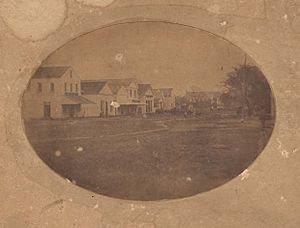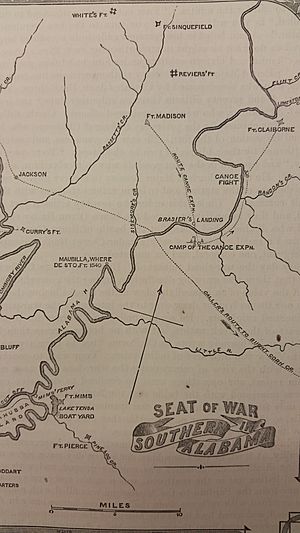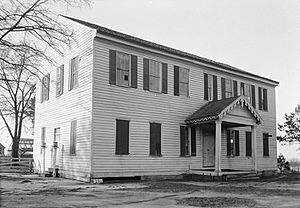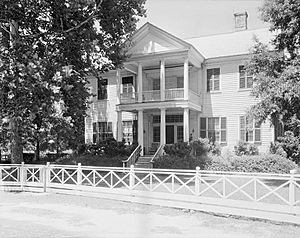Claiborne, Alabama facts for kids
Quick facts for kids
Claiborne, Alabama
|
|
|---|---|

A street in Claiborne during the 1850s
|
|
| Country | United States |
| State | Alabama |
| County | Monroe |
| Elevation | 180 ft (50 m) |
| Time zone | UTC-6 (Central (CST)) |
| • Summer (DST) | UTC-5 (CDT) |
| ZIP code |
36445
|
| Area code(s) | 251 |

Claiborne is a fascinating ghost town located on a high cliff overlooking the Alabama River in Monroe County, Alabama. A ghost town is a place where most people have left, leaving behind empty buildings and a quiet history.
Contents
History of Claiborne
Early Days and Fort Claiborne
Claiborne started out near the Federal Road, an important route for travelers. It began with a simple ferry crossing the river. During the Creek War, a large stockade fort was built here. This fort was called Fort Claiborne.
General Ferdinand Claiborne used this fort as a base. From here, he led an invasion into the Creek nation. His forces included the U.S. Army, local militia, and friendly Choctaw people. The community of Claiborne officially began in 1816, right on the old fort site.
A Growing Town with Famous Faces
After the war, Claiborne quickly became one of the biggest and fastest-growing places in what would become Alabama. Many important people lived here early on. Three future governors of Alabama lived in Claiborne: John Gayle, John Murphy, and Arthur P. Bagby.
William B. Travis, a famous hero from the Alamo, also lived in Claiborne for many years. He left for Texas in 1831. Other important politicians like James Dellet and Charles Tait also called Claiborne home.
In 1819, General John Coffee surveyed the community. He numbered the lots, and they were sold. Claiborne officially became a town on December 20, 1820, thanks to the Alabama Legislature.
River Travel and Special Visitors
In 1821, the first paddle steamer named the Harriet traveled up the Alabama River and landed at Claiborne. By this time, about 2,000 people lived there. The town grew even more, reaching 2,500 residents by 1825.
In April 1825, a very special guest arrived: the Marquis de Lafayette. He was on his famous tour of all 24 U.S. states. He was welcomed in the newly built masonic hall. This building, along with William B. Travis's house, still exists today. However, they were later moved to the nearby community of Perdue Hill.
Peak Population and Decline
Claiborne continued to grow in the 1830s, with its population reaching about 5,000 people. It was the first county seat (the main town for county government) of Monroe County. But in 1832, the county seat moved to Monroeville, which was more central.
By then, Claiborne had two large hotels, many stores, a cotton warehouse, a jail, a school, and several churches. However, outbreaks of sickness, like yellow fever and cholera, slowed the town's growth. During his visit to North America, a scientist named Charles Lyell collected fossil samples in Claiborne.
Claiborne remained an important shipping and trading center through the 1840s and 1850s. During the American Civil War, military defenses were built along the Alabama River, including at Claiborne. The town suffered damage and was looted at the end of the war.
After the war, Claiborne quickly lost its importance. By 1872, only about 350 people lived there. When a new railroad was built through Monroe County in the early 1900s, it bypassed Claiborne. This sealed the town's fate. By 2008, only the James Dellet House and three old cemeteries remained at the site.
Claiborne also had its own newspaper, the Alabama Courier, which was published from 1819 to the 1820s.
Population Facts
Claiborne appeared only once in the official U.S. Census records. In 1880, its population was 199 people. At that time, it was the largest community in Monroe County.
Geography of Claiborne
Claiborne is located at 31°32′25″N 87°30′56″W / 31.54016°N 87.51554°W. It sits at an elevation of about 180 feet (55 m) above sea level.
Notable People from Claiborne
- Arthur P. Bagby Jr.: A lawyer, editor, and a Confederate States Army colonel during the American Civil War.
- William B. Travis: Famous commander of the Alamo in 1836. His wife and son lived in Claiborne, Alabama.





